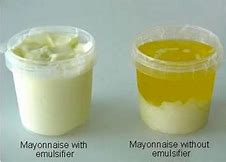ChatGPT said: Steps emulsifiers support luxury cosmetic formulations
Emulsifiers: Trick Components for Attaining Completely Combined Formulas
Emulsifiers play an important duty in creating secure mixtures of immiscible liquids, such as oil and water. Their unique residential or commercial properties permit them to lower surface area stress, which is essential for uniformity in numerous formulas. Comprehending the distinctions between all-natural and synthetic emulsifiers can affect product top quality significantly. As sectors increasingly seek to enhance structure and rack life, the selection process for the appropriate emulsifier becomes vital. What variables should be taken into consideration in this essential selection?
Understanding Emulsifiers: What They Are and How They Work
Although emulsifiers may look like a simple enhancement to formulations, they play a vital role in maintaining mixtures of components that commonly do not mix well, such as oil and water. These substances function by reducing surface stress at the user interface in between immiscible liquids, allowing them to mix even more evenly. Emulsifiers have both hydrophilic (water-attracting) and lipophilic (oil-attracting) buildings, which enable them to anchor themselves at the border of the 2 phases. By doing so, they create a safety barrier that prevents the droplets of one liquid from coalescing right into larger masses, thereby preserving a stable solution. The effectiveness of an emulsifier depends upon its molecular structure, which influences its capacity to stabilize blends. In different applications, from foodstuff to cosmetics, emulsifiers assure a constant texture and look, improving both capability and consumer appeal. Their relevance can not be overstated in achieving well-blended solutions.
Sorts of Emulsifiers: All-natural vs. Synthetic
Emulsifiers can be broadly classified into 2 types: synthetic and natural, each offering distinct advantages and applications. Natural emulsifiers, originated from plant or pet sources, include casein, lecithin, and periodontal arabic (emulsifiers). These emulsifiers are often favored in clean-label and organic items because of their marginal handling and biocompatibility. Their gentle nature makes them ideal for sensitive solutions, particularly in food and cosmetics

On the various other hand, artificial emulsifiers such as mono- and diglycerides, and polysorbates are made via chemical processes. They are generally used in commercial applications as a result of their stability and effectiveness in developing emulsions. Synthetic emulsifiers commonly display superior performance in severe conditions, such as heats or varying pH degrees. The option in between artificial and natural emulsifiers mostly relies on the specific formulation demands, governing considerations, and consumer preferences, influencing their efficient application in different markets.
Functions of Emulsifiers in Food and Cosmetic Formulas
The role of emulsifiers prolongs past simple stablizing; they are essential in accomplishing the preferred appearance, rack, and appearance life of food and cosmetic products. In food formulas, emulsifiers help blend oil and water, producing consistent and smooth textures necessary for sauces, dressings, and milk items. They decrease surface tension, boosting the security of solutions, which protects against splitting up and extends freshness.
In cosmetics, emulsifiers guarantee that ingredients, such as oils and water, mix seamlessly, boosting and giving an enjoyable feel application. emulsifiers. They add to the item's thickness and spreadability, important for lotions, lotions, and creams. Additionally, emulsifiers can envelop active components, enhancing their distribution and More Help performance in solutions. By regulating appearance and boosting sensory characteristics, emulsifiers play a vital role in meeting consumer expectations in both food and cosmetic industries, guaranteeing products are not only appealing but also functionally reliable
Choosing the Right Emulsifier for Your Product

Furthermore, the target application-- whether for food, cosmetics, or pharmaceuticals-- will influence the option. For example, food-grade emulsifiers should adhere to security regulations, while cosmetic emulsifiers may call for skin compatibility. Examining elements such as HLB (Hydrophilic-Lipophilic Equilibrium) helps in forecasting emulsifier habits in details formulations. Inevitably, a complete assessment of both regulatory factors to consider and useful requirements is necessary to select one of the most reliable emulsifier, making certain the final product meets the desired quality and stability standards.
:max_bytes(150000):strip_icc()/eating-well-emulsifier-dressings-3021330094034a48961553c1a8aea356.jpg)
Tips for Successful Emulsion Development and Security
Accomplishing successful emulsion formation and security needs careful attention to several critical variables. First, the choice of emulsifier plays an essential role; it needs to be compatible with the oil and water phases to assure effective stabilization. Second, the proportion of oil to water need to be well balanced, as an incorrect ratio can result in instability. Third, the mixing process needs to be controlled; high shear mixing can assist accomplish smaller sized droplet sizes, boosting stability.
Temperature likewise affects go to website emulsion stability; keeping optimal temperature levels during formula protects against premature separation. In addition, including stabilizers such as thickeners can further improve thickness, reducing the probability of stage splitting up. Conducting extensive security tests after formulation will assist determine prospective concerns, permitting for adjustments prior to last manufacturing. By sticking to these standards, formulators can achieve consistent and trustworthy emulsions that preserve their preferred properties over time.
Frequently Asked Questions
Can Emulsifiers Be Made Use Of in Vegan Formulations?
Yes, emulsifiers can be used in vegan formulations. Lots of plant-based emulsifiers, such as lecithin from soy or sunflower, give reliable mixing without animal-derived components, making them appropriate for a variety of vegan products.
What Are Usual Irritants in Emulsifiers?
Usual irritants in emulsifiers include soy, milk, and eggs, as particular emulsifiers are originated from these resources. Furthermore, some individuals may react to preservatives or additives made use of alongside emulsifiers in different solutions.

Just How Do Emulsifiers Effect Rack Life of Products?
Emulsifiers improve product security by protecting against separation of active ingredients, consequently extending service life. They minimize wasting triggered by microbial growth and oxidation, bring about prolonged quality and improved high quality in different food and aesthetic formulas.
Exist Any Type Of Health Concerns Associated With Emulsifiers?
Research shows prospective health problems connected with emulsifiers, including intestine microbiome changes and swelling. While regulative bodies normally consider them risk-free, recurring research studies remain to explore long-term impacts on health and total wellness.
Can Emulsifiers Improve Taste or Scent in Formulations?
Emulsifiers can boost flavor and fragrance in formulas by boosting ingredient diffusion and stability. This causes a much more consistent product, allowing flavors to fuse properly, eventually leading to an extra pleasurable sensory experience for customers.
Emulsifiers may appear like an easy enhancement to formulations, they play an important role in maintaining mixes of active ingredients that usually do not mix well, such as oil and water. In food formulations, emulsifiers aid blend oil and water, producing smooth and consistent appearances necessary for sauces, dressings, and milk products. Food-grade emulsifiers must conform with safety and security policies, while aesthetic emulsifiers might require skin compatibility. Common irritants in emulsifiers consist of soy, dairy, and eggs, as certain emulsifiers are next obtained from these resources. Emulsifiers can boost flavor and scent in solutions by improving ingredient diffusion and stability.